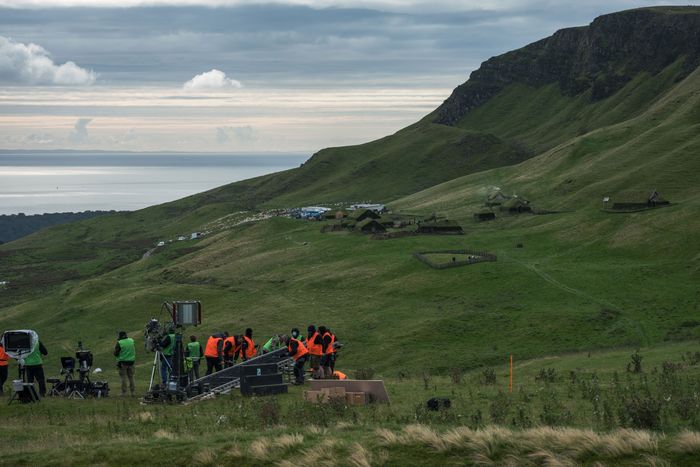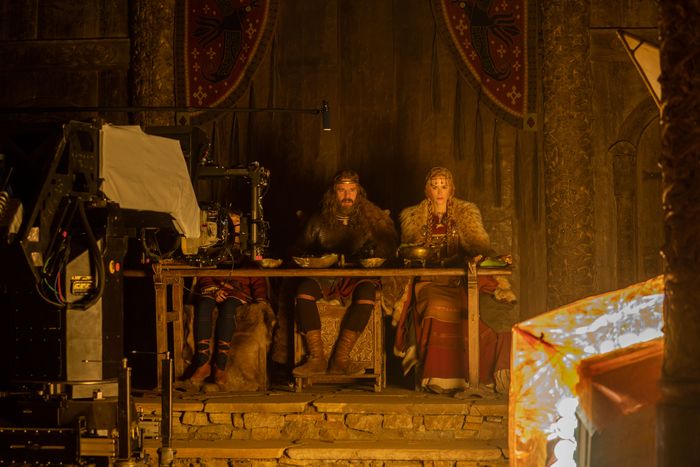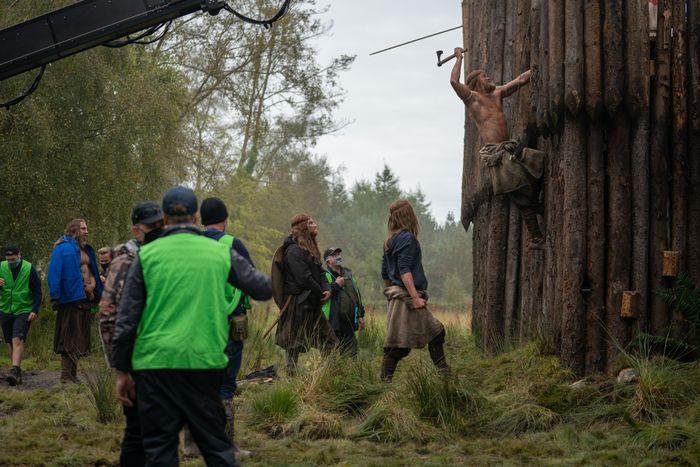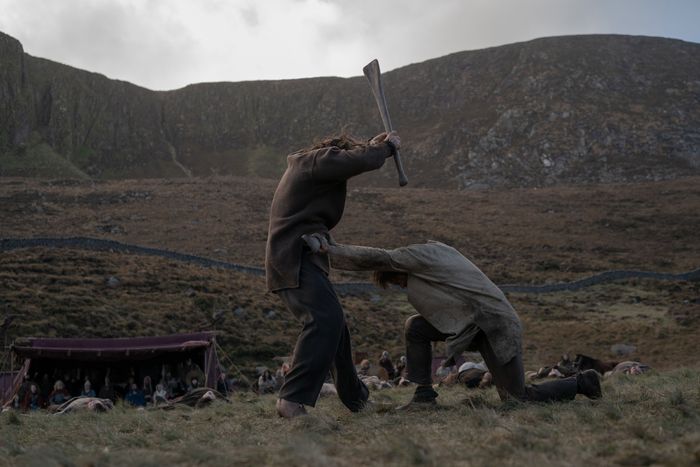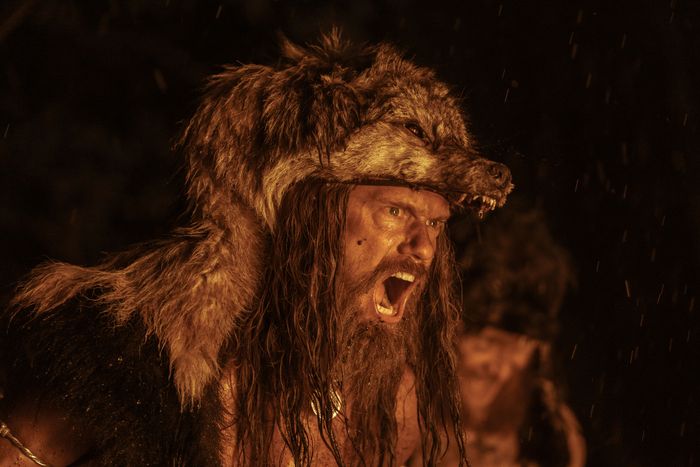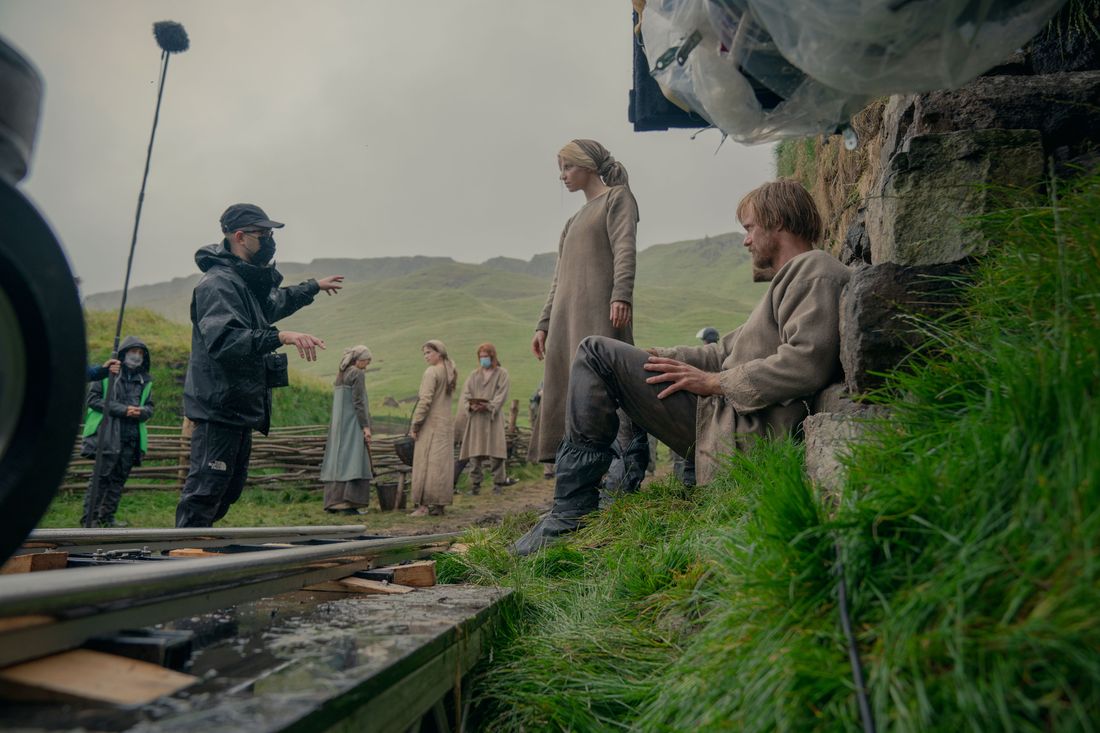
When the director Robert Eggers announced that his next film, The Northman, would be a loose adaptation of the medieval Icelandic saga that inspired Hamlet, fans knew they were in for an exhaustively researched Viking epic: nasty, brutish, and long. While Eggers has made films set in the past — 2016’s The Witch was a horror film set in Puritan Massachusetts; 2019’s The Lighthouse a psychodrama about turn-of-the-century lighthouse keepers — shootingThe Northman meant working at a scale he never had before. As Eggers puts it: “We did not have the experience to be making this film.”
Besides the painstaking period detail and battle sequences that demanded everything from star Alexander Skarsgård, Eggers’s aesthetic added to the complexity. He and his cinematographer, Jarin Blaschke, prefer precisely planned long takes, dense with action, to make the audience “feel like the world exists well beyond the limits of the frame,” Blashke says. If something went wrong, they just had to start again from the beginning. Another hurdle? Being one of the first movies to start production under then-novel COVID protocols. And they did it all while navigating one of the most treacherous obstacles a film crew can encounter: Irish weather.
The Day We Rewrote the Film
Eggers’s co-author on the Northman script was the Icelandic poet and novelist Sjón, whom the director met over a salmon dinner at Bjork’s house. (To acknowledge her role as The Northman’s spiritual godmother, the singer has a cameo as a Viking witch.) For Sjón, the Icelandic sagas are “the only thing we have in this world to claim our seat at the table of civilization.” When he reads a particularly badass passage — like Skarphéðinn Njálsson’s joke about an adversary eating the ass of a mare — he can feel the joy of the storyteller echoing from a thousand years in the past. “That’s what I hope we manage to bring to The Northman, the joy of telling a story like that, even though it’s cruel and hard and dark,” he said.
At first glance, the style of the Icelandic sagas is well suited to cinema. As in a screenplay, Sjón said, characters are only developed through their words and their actions. “They never reveal anything of the inner life of the characters.” His and Eggers’s shooting script matched the sagas’ “dry, emotionless way of storytelling.” Unfortunately, this turned out to be a case of too much historical accuracy. Test audiences were baffled by early cuts of the film. The studio, of course, had notes. Everything from Amleth’s motivations to the concept of Valhalla needed to be more legible. However, the film had already been shot. And since the action plays out in a series of majestic long takes, there was a limit to how much could be reshaped in the editing room.
The solution was found in the recording booth. Eggers and Sjón realized they could write new dialogue that led the audience deeper into Amleth’s psyche, and have the actors ADR it in. A simple enough task, except for the fact that the new words would have to match the lip movements of the old words exactly, while also staying true to medieval parlance. Sjón called it “the toughest crossword puzzle you can imagine.”
“You’re like, ‘Okay, we’ve got 18 syllables. The fifth syllable has to be a T because he enunciates that T so well,’” Eggers said. “Maybe you could get away with a D. And then this syllable has to be an S.”
Sjón’s experience writing lyrics with Bjork was “the best training” possible. (“She would give me a scratch demo of herself humming and I had to fit words into the strange Dadaist nonsense.”) Still, rewriting was painstaking work. A “well” could become a “hell” and a “must” could become a “just,” and then all of a sudden, they had, “At the gates of Hell, there will my sword be just.” But to Sjón, the difficulty was the point. “Why would you do a historically accurate medieval tale that takes place in three countries, involving battles, family feuds, and magical beings, and not expect it to be hard?”
The Day We Shut Down for COVID
“We were a week away from going to camera, and we shut down,” said production designer Craig Lathrop. Lathrop had worked on The Witch and The Lighthouse and was used to Eggers’s exacting standards of historical realism. By early March, Lathrop had spent nine months diving into the world of the Vikings. He read scholarly journals, visited museums in Oslo and Copenhagen to see old Viking ships, and went to Iceland to experience a reconstructed turf longhouse. “It was nice to see it, and smell it,” he said.
The Northman, partially shot in Northern Ireland, would be a daunting feat of production design: two villages, an Icelandic farm, three temples, a cave. “We built everything,” Lathrop said. “Including most of the set decoration, from the chairs, to a tapestry, to a nine-foot solid-wood idol.” A man in the Czech Republic constructed working Viking longships. (Though if you have visions of them sailing down the Danube, I regret to inform you the longships traveled to the Northman set via shipping container, which during the pandemic was its own kind of logistical nightmare.) The team also had to build the things you didn’t see, including solid foundations that would prevent the outdoor sets from sinking into the muddy Irish pasture. Some of the locations were so remote, they even had to construct their own roads.
The most challenging construction task was the farm of Fjölnir (Claes Bang), where the second half of the film is set. Real Icelandic buildings of the period were constructed out of solid layers of turf, the sod and the peat together. Lathrop had never built a turf house before, and barely knew where to start. No one in Ireland cut the thick pieces of turf the way they needed. So they cheated. They built a solid skeleton of the house, then got a guy to cut some peat, someone else to grow their sod wild and long, put it all together, and voila — a dirty, stinky turf house covered in beautiful green grass.
Then, on March 12, the film went on hold, with no immediate plans for returning. There was a real possibility Lathrop’s months of work were for nothing. Even if the film did eventually start back up, he might come back to set to discover the outdoor sets were ruined, especially as Northern Ireland was suffering its worst drought in decades. “There wasn’t any rain,” Lathrop said. “It was all dying.”
Fortunately, Lathrop got permission to hire a greensman. And so, at the height of a pandemic, a gardener traveled to an abandoned movie set and watered the fake Viking longhouse twice a week. This turned out to be money well spent. When production started back up again at the end of the summer, the set looked even better than it had in March. “By the time we got back, it had really settled in. It didn’t feel as fresh as it did before,” Lathrop said. “Hell of a way to get there. I don’t recommend having a global pandemic to allow your sets to mature.”
The Day We Decided What Viking Tables Looked Like
Everything that the production designers built had to live up to Eggers’s rigorous historical standards. Aiding in this task was Professor Neil Price, archeology chair at Uppsala University, one of multiple historical advisors to the film. An Englishman who moved to Sweden to study the Vikings as they saw themselves — not as they were seen by Anglo-Saxons — Price is fascinated by their pre-Christian culture. “You could ask a Viking, ‘What is your religion?’ They wouldn’t have understood,” he said. “Because to them there is no such thing as the supernatural. Everything is natural. If you asked, ‘Do you believe in elves?’ it’s like saying, ‘Do you believe in mountains?’ Of course you do. It’s not belief.”
Price specializes in material culture, the physical objects that give us a clue into the Norsemen’s daily lives. “It’s a very vibrant world,” he said. “They decorated everything, including human skin. Their burials are like little plays, and every one is different.” Unfortunately, they also left few written records; we only have the story of Amleth thanks to a 12th-century history of the Danes, which builds on earlier material now lost to us. Repeating the level of accuracy as The Witch or The Lighthouse was never going to be possible. “It’s 1,000 years in the past. We simply can’t get that resolution of detail,” Price said. “There’s always this gap between what we all want, and what we can do.”
He pointed to something as basic as a banquet scene, a trope The Northman does not spare us. There’s one fundamental problem: “We don’t know what Viking tables look like.” Obviously there are legs, presumably they’re flat on top. “But exactly how do people sit? Do they have an order of precedence around a table? If we left blank everything that we didn’t know, they’d be wandering out in a fog.”
The only thing to do is to make an educated guess, which is where all the Ph.D.s come in. “But we’re fencing in those guesses as tight as we can,” Price said. And fortunately, there were still opportunities for Eggers & Co. to unleash the full power of their historical knowledge. In a scene set in a burial mound, everything inside the grave dates to 200 years before the film is set, a trove of Easter eggs for Viking Sword Twitter.
The Day We Battled the Tides
Robert Eggers did not grow up a Viking fanboy. They were a little too macho for a kid who loved history and the theater, and as he got older, the “right-wing misappropriation of Viking culture” was an added turnoff. But on a trip to Iceland in 2016, he became fascinated by the landscape. That led him to the sagas, and those led him to making The Northman.
The film is full of show-stopping set pieces, including a single-take raid on a Slavic village involving dozens of extras, horse stunts, and massive special effects. “Funnily enough, sometimes it was the smaller scenes that we didn’t really spend any time preparing for which were the hardest to shoot,” Eggers says. Take a simple scene of Alexander Skarsgård and Anya Taylor-Joy approaching a beach on horseback: Off the coast there is a ship. On the shore are two sailors lugging a rowboat out of the water. It’s a relatively basic shot. And yet it took around 35 takes to get right.
The first issue was the horses. “Horses are very smart and very trainable, but they’re not going to hit their mark with absolute precision,” Eggers said. The second was the tides. As the water went out, they had to continually reblock the scene to get closer and closer to shore. To add to the stress, the slope of the beach dropped off precipitously, which meant there was a limit to how far they could push. If they hadn’t got the shot by the time the tide went out, they weren’t going to be able to get it.
“Most people are shooting 18 to 25 setups a day; we shot between one and four,” Eggers said. “When it’s not in knee-deep mud on a windy mountainside with horses, it’s shooting a Viking ship in a storm at sea.” (That scene was done on a soundstage, but still, not easy.) And this was in Northern Ireland, which had returned to its usual weather — even the good days were still a little bit crap. “You can see when it’s pouring, you can see when the wind is whipping, but what you can’t see is drizzle,” Eggers said. “So many of the shots where it doesn’t look like it’s raining, it’s raining.”
If that sounds suspiciously close to a complaint, know that it’s not. “You can’t make this movie in L.A.,” Eggers said. He pointed to the opening of 1958’s The Vikings. Director Dean Fleischer and his crew traveled all the way to the Norwegian fjords, only to encounter sunny Scandinavian skies. “They might as well have shot it in California,” Eggers said. “For us, we needed that misery.”
The Days We Made Eight Shots Looks Seamless
For everyone who worked on The Northman, the raid on the Slavic village took a Herculean effort, involving all those extras and an entire farm’s worth of horses, goats, geese, and chickens. While the sequence appears to play out in a nearly continuous take, the raid was edited together from eight different shots filmed over the course of multiple days. It was the job of the visual-effects team, led by supervisor Angela Barson, to stitch them together.
Her work began well before post-production. Normally, Barson said, filmmakers wait until the editing phase to look through their 20 takes and decide which one is best. “Whereas I’m on set going, ‘You need to decide now.’” The sheer number of moving parts meant there was no end to the things that could screw up the flow: a horse not being in the right place, or an extra disappearing, then reappearing. “They may get a take and go, ‘Brilliant, loved everything.’ And then I’m like, ‘No, doesn’t work for the blend,’” Barson said. “I had to know I could make every stitch work seamlessly once we got back into the office.”
Understandably, this is not what a director wants to hear. “You know you’ve slightly disappointed Robert, or made him a little bit anxious, when he goes to the side and kind of looks down,” Barson said. Even more stressful was the toll resetting would have on the cast and crew. Every new take was one more time a horse would have to fall over, or a stuntman would have to do something dangerous.
The raid begins with the berserkers running towards the village wall, then climbing over it. It was clear that the next bit — where Skarsgård knocks a dude off a horse in midair, then keeps fighting— couldn’t be filmed in a single take. They needed to find a stitch point. But where? Here’s how they did it: After Skarsgård landed, the camera pulled in on his legs as he stomped on his adversary. The VFX team put the stitch in at the stomp, rebuilding part of the leg and adding more ground with CGI, and using a whip-pan to get a little motion blur. “I was quite impressed with what the artists did,” Barson said. “It was a bit like, How have you managed that? Nobody would have expected it to happen there.”
Few people watching the finished film will be aware of the cut, the surest sign of an effects job done right. “Throughout the film, visual effects are going to get the credit for a lot of stuff that’s done in-camera. And a lot of stuff we did do, they’re going to think was done for real,” Barson said. “The biggest compliment for us is that nobody really knows what we’ve done.”
The Day We Played an Ultraviolent Viking Field Game
Another benefit to the COVID-induced interruption was giving everyone time to work out the intricate set pieces. By time production resumed, only one had not been fully prepped: the Knattleikr sequence, where Amleth and his fellow slaves play a Viking ball game “so violent that some historians think they didn’t even keep track of” the score, Eggers said.
This brutal display of Old Norse shithousery was a test for the stunt team, led by veteran coordinator CC Smiff. “I come from the school of Ridley Scott and Tony Scott; we’d chuck cameras everywhere,” Smiff said. With a single camera, and long takes, his job became much more complex. On a safety level, more takes meant more opportunities for injuries. And on the artistic side, he said, “it’s hard to get that energy when you’re just following one man. Any point where he’s not actually doing something, that’s where you’d want to see a head smash or a limb snap. It livens the whole page up.”
Step one of the Knattleikr scene was coming up with the rules. The teams were made up of a mix of actors and stuntmen, and all of them needed somewhere to go and something to do. Precious little information exists about the game, but the version in the Northman is a mix of field hockey and rugby. As originally envisioned, a player needed to be on the ball to be hit. “That got boring, so we just started smashing everybody,” Smiff said.
The sequence was filmed on a remote location high up in the Morne mountains. Production had built a road going part way up, but because of protected land, it could only go so far. Much of the cast and crew had to hike a mile and half to get to the set, lugging equipment by hand. (Other, luckier people got to helicopter.) When they got up there, they had to deal with the rain. One day, the flooding got so bad they couldn’t shoot. “We were washed out,” Smiff said. “We lost our pitch. I thought waterfowl were going to come down on it.”
When the cameras were rolling, it didn’t get much easier. A stuntman got injured on the very first day of shooting. There was a COVID scare. Because of the rain, the ball kept slipping out of the players’ hands. And, being on top of a mountain, it was also bitterly cold. “The stunt guys and actors said that lying down on that grass was the worst experience of their life,” Eggers said. Hafþór Björnsson from Game of Thrones has a small role as one of the opposing players; in one take, he accidentally hit the actor Seamus O’Hara for real. “Seamus said that he would rather be hit in the face with a wooden club by the strongest man in the world, than lie in that grass again.”
At times Smiff sounds like a coach ruminating on the big game. “I think if we had a little more time …” he said, before catching himself. “I think it still sold well. I just wanted a few more hits and turns. Maybe that’s where I wanted my inserts — a head here, legs going up in the air. I wanted to go the whole nine yards, didn’t I?”
The Day We Thought We Nailed It, But Didn’t
“I always get a bit self-conscious talking about the hardships of filmmaking, because then I feel like a spoiled fucking brat,” Alexander Skarsgård said. “Everyone’s like, ‘We know you had your assistant waiting with a coffee …’” But The Northman presented more challenges for its star than a typical Hollywood movie.
The night before the raid, Amleth and his fellow berserkers are hyping themselves up for the following morning’s pillage; they switch off their human minds and become beasts of war. “Technically, it wasn’t the most difficult scene,” Skarsgård said. “But what made that one tough was the transformation. The characters go into a trance and then they turn into their spirit animals.” He compared it to a Frances Bacon painting: “They revert back to something primal.”
Over the course of a night’s shooting, the actor and his co-stars powered themselves on pure adrenaline. “It’s exhausting doing it one time, but then you do it over and over again, and it’s wet and cold and you’re just in it, letting go of inhibitions and throwing yourself out there,” Skarsgård said. Finally, after more than 20 takes, they got the shot. The performers were elated: They could finally take off those wet pelts and head towards the cars that would usher them off to their nice, warm beds.
But before they could pull away, the first AD arrived with terrible news: A drop of rain had landed on the camera lens, ruining the take. They would have to go back. On the walk to the set, Skarsgård remembers the 12 drained berserkers “crying like children.” But they didn’t have a choice. They stepped back into the pelts, and prepared to go again.




